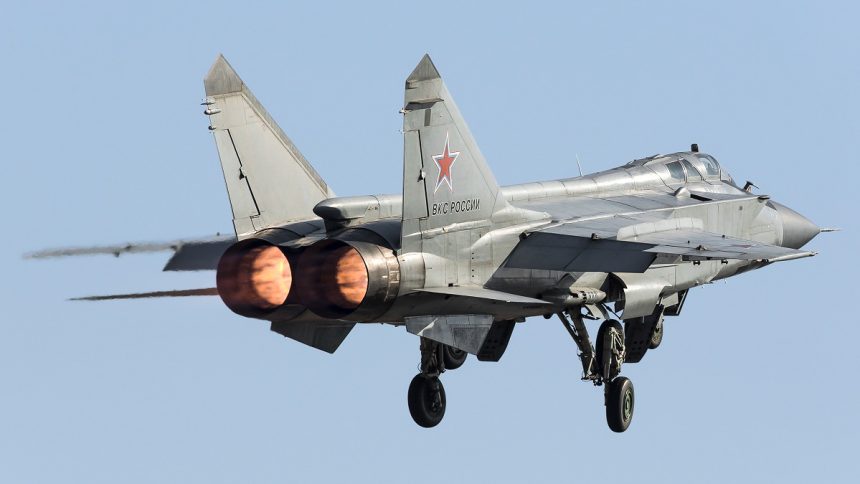The Russian Navy MiG-31BM Foxhound interceptors flew over the North Pole within the framework of the current Arctic deployment.
Two MiG-31BM Foxhound interceptors have flown over the North Pole, in what was a first for Russian Naval Aviation. “Within the framework of an Arctic expedition for the first time ever in the history of Russian Navy a pair of MiG-31 jets performed a flight over the North Pole and were refueled in midair,” said the Navy’s commander-in-chief, Nikolai Yevmenov. Russia’s President President Putin was also briefed about the significant milestone.
A squadron of MiG-31BM Foxhound has been deployed to Rogachevo Air Base in the Novaya Zemlya archipelago, on the eastern Barents Sea, one of the northernmost regions of Russia and the perfect forward operating location to launch missions in the strategic Barents and Arctic region.
“The crews of the MiG-31BM fighter-interceptors of the separate mixed aviation regiment of the Northern Fleet took up combat duty to guard the border in the airspace on the Novaya Zemlya archipelago,” announced the Russian Ministry of Defense (MoD) earlier this year. “Alert duty will significantly expand the scope of the Northern Fleet’s fighter aircraft in the Arctic and significantly increase the controlled airspace over the Northern Sea Route.”
Экипажи истребителей #МиГ-31БМ морской авиации Тихоокеанского флота провели за полярным кругом учение по перехвату условного самолета-нарушителя границы Российской Федерации в воздушном пространстве https://t.co/A8ndpjaDv4#ВВО #Минобороны #Авиация #Анадырь #БоеваяПодготовка pic.twitter.com/DelF5iHzBF
— Минобороны России (@mod_russia) March 10, 2021
This is the first time a QRA (Quick Reaction Alert) squadron operates from the Rogachevo airfield on Novaya Zemlya, although Russian Navy MiG-31BM interceptors already performed a number of training tasks from there in 2020.
The mission over the North Pole comes amid growing tensions between the U.S. and Russia in the Arctic region where the U.S. Air Force has recently flown a quite unusual mission that saw the integration of both B-1s and B-2s bombers. Here’s what this Author wrote about that mission:
However the joint mission is remarkable because it shows a growing pivot to the strategic Arctic theater, the “battlefield” for an intensifying struggle between the U.S. and other “Western” Arctic states and Russia, for military as well as economic reasons (mostly related to energy extraction and maritime shipping activities). The presence of four strategic bombers not far from the Barents Sea, dubbed “Russia’s Naval Backyard“, is probably going to increase tension in the area, already at a high level after the first ever deployment on Norwegian soil of four U.S. Air Force B-1 bombers. As to the type of mission profile flown by the the U.S. bombers during the training mission on Mar. 16, 2021, there’s a wide variety of possibilities, from a routine sortie to train with the C2 (Command and Control) agencies and restriction in the region, to far more complex stuff (as, just for example, flying a simulated combined attack on the Russian Navy Northern Fleet).
First flown in 1975, the MiG-31 Foxhound is a replacement for the similarly configured MiG-25 Foxbat, a high-speed, high-altitude interceptor originally conceived in response the U.S. XB-70 Valkyrie Mach 3+ strategic bomber that never entered service. The Foxbat achieved notoriety on September 6, 1976, when Russian pilot Viktor Belenko defected to Japan with a MiG-25. While the airframe and engines remain the same of the original Cold War-era MiG-31, the latest variant of the Foxhound, the MiG-31BM, features upgraded avionics, with new LCD displays in both the pilot’s and WSO’s cockpits, improved radar, and ability to reach a top speed of Mach 2.8 (cruise speed is M2.3). New capabilities include hypersonic missiles and even a small satellite launch capability that was tested.
As already reported, the MiG-31s took part in an exercise simulating a mock intercept of “enemy aircraft” violating the borders of the Russian Federation in an attempt to launch a missile and bomb strike on strategic military targets was carried out over Eastern Russia, in the Chukotka autonomous district. The MiG-31BMs of the Russian Navy’s Pacific Fleet performed a simulated intercept of a mock enemy (another MiG-31) over the Artic Circle, which was flying “at supersonic speed and at an altitude of about 20 kilometers” (about 65.600 ft). In fact, considered its max speed and ceiling (in excess of 65,000 feet) and range of 1,242NM (2,300 km), the Russian Navy MiG-31BM represents a threat to any asset in the region.









